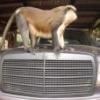-
Content Count
102 -
Joined
-
Last visited
Community Reputation
16 GoodAbout swamp thang
-
Rank
Born Hunter
Profile Information
-
Location
Canada QC
-

Antelope From the African Swamp
swamp thang replied to swamp thang's topic in Deer Stalking & Management
I've heard of the Wells catfish in Spain's River Ebro, Sniffer. There have been a couple of Discovery Channel programs on those monster Wells, one of which included an interview with a German angler who is credited with illegally introducing Wells into the Ebro River back in the 1970's, by driving over there from Germany in his car, with a few hundred fingerlings that he released into the river. Hatching here starts at night with a hormonal injection of a Canadian-manufactured drug called Ovaprim, to both parent stock. This is only done in the rainy season from about May to September, wh -

Antelope From the African Swamp
swamp thang replied to swamp thang's topic in Deer Stalking & Management
I sell catfish fingerlings, when they are six weeks old, and about an inch long, Sniffer. My hatchery creates a reproductively sterile but fast growing cross-breed of two African catfish, the Heterobranchus logifilis, which can grow quite big in the wild, and the Clarias "walking" catfish, which reaches a smaller adult size. Those fingerlings are raised by local farmers for 4 to 6 months when they reach a couple of kilos in size, and then sold by weight in markets here. Both parent stock and their fast-growth offspring are air-breathing catfish which are generally sold alive by the fish farm -

Antelope From the African Swamp
swamp thang replied to swamp thang's topic in Deer Stalking & Management
I'm in west Africa. The website mods know exactly where of course, but just in case any government officials from this neck of the woods are listening in, I can't be too specific, given the way firearm permits get revoked here from time to time, and hunting weapons "confiscated", as a prelude to, ahem, re-distribution of said weapons to more "deserving" owners. -

Antelope From the African Swamp
swamp thang replied to swamp thang's topic in Deer Stalking & Management
Hello Jonah, The camera is the Covert Black 60 trailcam, one of the new generation of "black flash" infra-red cameras whose flash is not visible to the human eye. This camera really comes into its own at night, and has the brightest "invisible" flash on the market right now, which really lights up the night better than most other models on the market. The bushbuck are kept in a really small area of maybe an acre at best, surrounded by 8-foot high chain-link fence. I keep them mostly for visitors and schools to look at, but the bucks get terrirotial during their rut, and the dominant -

Antelope From the African Swamp
swamp thang replied to swamp thang's topic in Deer Stalking & Management
Hello Skycat, When I first started out trying to raise bushbuck in captivity with a few orphaned fawns some years back, I was fairly confident from my years of hunting them that I knew all the varieties of foliage that they eat, but I found out that the leaves and vines that were being brought in for them were still lacking in some key nutrient that I couldn't put my finger on. Finally a man who kept goats showed up, and noting how skinny the bushbuck in the pen were back then, suggested I try feeding them raw beans like he fed his goats, but only if the beans had been soaked for 3 to -

Antelope From the African Swamp
swamp thang replied to swamp thang's topic in Deer Stalking & Management
The bushbuck herd in the pen out back aren't anywhere near tame, so the only way I was able to get this group closeup was to put a trail-camera out when they gather for lunch. Without this addition of pre-soaked beans to supplement their diet of leaves, these animals just waste away and won't breed at all. They also get cattle salt-lick blocks for their minerals. Almost all of these were born in captivity, though I do buy the odd fawn from local hunters who would otherwise feed them to their hunting dogs, and those youngsters get bottle-fed till they can eat greens. -
Beware the rampaging deer, for he hath no fear, when he's had a beer. The reactions of those pedestrians was nice to watch. They just glanced back over their shoulders, as if they were expecting a procession of deer to follow the first one down the street.
-
Hello Pledgey, the very best website I have found for trail cameras on the internet is called "chasing game.com". That website is frequented by a lot of very experienced trail cam users from all over the world, and some of those guys have up to twenty cameras set up on their land. The "Chasing Game.com" website carries detailed user test results from all the latest trail cameras on the market, plus some of the most amazing collections of wildlife pictures taken with trail cameras owned by subscribers to that website. From my limited experience with trail cameras, the ones to avoi
-

Antelope From the African Swamp
swamp thang replied to swamp thang's topic in Deer Stalking & Management
Just seen the Muntjac picture. Looks a lot like an African Duiker. Muntjacs are supposed to be Asian originally, I read somewhere. -

Antelope From the African Swamp
swamp thang replied to swamp thang's topic in Deer Stalking & Management
Ok I managed to get a couple of shots of my captive Sitatunga, named Swampy by my eight-year old. He is about half grown now, comparing his horns to those of the one I caught on film by the river-side. Very nervous animal this one, even though he will walk up to people he knows. We had to suspend re-roofing a shed nearby, because he went haywire with the carpenters noise, and wouldn't eat for a week. Here he is snacking on his favourite treat - Moringa olifera leaves. Here is another shot. I was about to crouch down to get a petter perspective, but his hackles went up, and -

Antelope From the African Swamp
swamp thang replied to swamp thang's topic in Deer Stalking & Management
The forest runs in a narrow ribbon along the banks of a stream, Skycat, and it is there that these animals find refuge from year- round unrestricted hunting pressure. The bushbuck (Tragelaphus scriptus) is actually a grassland species, but this small group have adapted to skirting the edges of the swamp behind my catfish ponds, where the hunters and their dogs don't go due to difficult terrain. The far more rare and stealthy Sitatunga ( Tragelpahus spekei gratus), shown in my earlier night pictures, is a slightly larger cousin of the bushbuck, and is a purely swamp-dwelling antelope, wit -

Antelope From the African Swamp
swamp thang replied to swamp thang's topic in Deer Stalking & Management
Thought I'd add this shot to show that the stripes don't fade on adult bush-bucks. Here a doe and fawn take a stroll. -
Great description of the hunt, Matt. I could almost feel the cold wind in my face, reading about that rainy day stalk. The landscape where you hunt is picture-postcard beautiful, I must say. Nice shots of the land, and of the quarry. You bagged a fine beast there.
-

Antelope From the African Swamp
swamp thang replied to swamp thang's topic in Deer Stalking & Management
Thought I'd add this picture that shows a bit of the swamp forest. The raised embankment on which this fawn stands was built by the dozer digging fish ponds years ago, and is now plastered with antelope tracks, and tore up with horn scrapes. The camera that I set here ten feet up a palm tree is by far the most productive trail-cam I have out there.This is the same spot where the Sitatunga emerges from the swamp, but in the dead of night only.Here Here again is the same Sitatunga using his horns to apply his stamp of authority, to show who's in charge in this area. -
Thought you fellas might appreicate a few pictures of the species that are hunted here. Don't do much shooting myself these days, seeing as the habitat hs shrunk so much that these species are all pretty much endangered here. Anyways, here goes. This is about my best closeup of a bushbuck in the wild, as she grazed on the edge of my catfish pond at dawn. Next is a group shot of my captive herd of bushbuck. I will get around to taking a closeup at feeding time one of these days. Now this is the King of the Swamp, the Sitatunga swamp antelope, which is as elusive and ha


